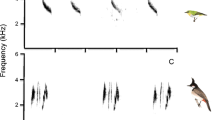Abstract
Mating aggregations of three species of periodical cicadas were monitored during the emergence of Brood XIX at a 16-ha study site in northwest Arkansas, May–June 1985. Magicicada tredecassiniappeared first and formed the most choruses. M. tredecimand M. tredeculachoruses formed next, and M. tredeculachoruses outnumbered those of M. tredecim.Of the 268 choruses seen, 84% were composed of M. tredecassini. M. tredecassiniwere often found chorusing in the same trees with the other two species. Such multispecies mating aggregations apparently are unique to periodical cicadas. Choruses were dynamic with respect to their locations and durations. Initially, choruses were located near areas of high cicada emergence densities. One week later, cicadas chorused in trees throughout the forest and at the forest edge. Many choruses were seen only once at a location. Although cicadas chorused for almost 4 weeks, individual choruses persisted only approximately 8 days, on average. Sound intensities under chorus centers ranged from 50 to 80 dh and were correlated with arena sizes during times of peak chorus activity. No distinct habitat preferences of the three species were observed, however, the tree species used by chorusing cicadas differed among the species.
Similar content being viewed by others
References
Alexander, R. D., and Moore, T. E. (1958). Studies on the acoustical behavior of seventeen-year cicadas (Hompotera: Cicadidae:Magicicada.Ohio J. Sci. 58: 107–127.
Alexander, R. D., Moore, T. E. (1962). The evolutionary relationships of 17-year and 13-year cicadas, and three new species (Homoptera, Cicadidae,Magicicada).Univ. Mich. Mus. Zool. Misc. Publ. 121: 1–59.
Alexander, R. D. (1975). Natural selection and specialized chorusing behavior in acoustical insects. In Pimentel, D. (ed.).,Insects, Science and Society, Academic Press, New York, pp. 35–77.
Beamer, R. H. (1931). Notes on the 17-year cicada in Kansas.J. Kans. Entomol. Soc. 4: 53–58.
Bradbury, J. (1981). The evolution of leks. In Alexander, R. D., and Tinkle, D. W. (eds.),Natural Selection and Social Behavior: Recent Research and Theory, Chiron Press, New York, pp. 138–169.
Dunning, D. C., Byers, J. A., and Zanger, C. D. (1979). Courtship in two species of periodical cicadas,Magicicada septendecim andM. Cassini.Anim. Behav. 27: 1073–1090.
Dybas, H. S., and Davis, D. D. (1962). A population census of 17-year periodical cicadas (Homoptera: Cicadidae:Magicicada).Ecology 43: 432–443.
Dybas, H. S., and Lloyd, M. (1962). Isolation by habitat in two synchronized species of periodical cicadas (Homoptera: Cicadidae:Magicicada).Ecology 43: 444–459.
Dybas, H. S., and Lloyd, M. (1974). Habitats of 17-year periodical cicadas (Homoptera: Cicadidae:Magicicada spp.).Ecol. Monogr. 44: 279–324.
Gwynne, D. T. (1987). Sex-biased predation and the risky mate-locating behavior of male ticktock cicadas (Homoptera: Cicadidae).Anim. Behav. 35: 571–576.
Heath, J. E. (1967). Temperature responses of the periodical “17-yr” cicada,M. Cassini (Homoptera, Cicadidae).Am. Midl. Nat. 77: 64–76.
Huber, F., Wohlers, D. W., and Moore, T. E. (1980). Auditory nerve interneurone responses to natural sounds in several species of cicadas.Physiol. Entomol. 5: 25–45.
Karban, R. (1981a). Flight and dispersal of periodical cicadas.Oecologia. 49: 385–390.
Karban, R. (1981b). Effects of local density on fecundity and mating speed for periodical cicadas.Oecologia. 51: 260–264.
Karban, R. (1982). Increased reproductive success at high densities and predator satiation for periodical cicadas.Ecology. 63: 321–328.
Karban, R. (1983). Sexual selection, body size, and sex-related mortality in the cicadaM. Cassini.Am. Midl. Nat. 109: 324–330.
Lloyd, M., and Dybas, H. S. (1966). The periodical cicada problem. II. Evolution.Evolution. 20: 466–505.
Lloyd, M., and Karban, R. (1983). Chorusing centers of periodical cicadas.J. Kans. Entomol. Soc. 56: 299–304.
Lloyd, M., and White, J. (1976). On the oviposition habits of 13-yr vs 17-yr periodical cicadas of the same species.J. N.Y. Entomol. Soc. 84: 148–155.
Lloyd, M., White, J., and Stanton, N. (1982). Dispersal of fungus-infected periodical cicadas to new habitat.Environ. Entomol. 11: 852–858.
Maier, C. T. (1982a). Observations on the 17-yr periodical cicada,M. septendecim (Hemiptera: Homoptera: Cicadidae).Ann. Entomol. Soc. Am. 75: 14–23.
Maier, C. T. (1982b). Abundance and distribution of the seventeen year periodical cicada,Magicicada septendecim (Linnaeus)(Hemiptera: Cicadidae-Brood II), in Connecticut.Proc. Entomol. Soc. Wash. 84: 430–439.
Marlatt, C. L. (1907). The periodical cicada.U.S. Dept. Agr. Bur. Entomol. Bull. 71: 1–181.
Parker, G. A. (1978). Evolution of competitive mate searching.Annu. Rev. Entomol. 23: 173–196.
Pinto, J. D. (1980). Behavior and taxonomy of theEpicauta maculata group (Coleoptera: Meloidae).Univ. Calif. Pub. Entomol. 89: 1–111.
Simmons, J. A., Wever, E. G., and Pylka, J. M. (1971). Periodical cicadas: Sound production and hearing.Science 171: 212–213.
Simon, C., Karban, R., and Lloyd, M. (1981). Patchiness, density, and aggregative behavior in sympatric allochronic populations of 17-year cicadas.Ecology. 62: 1525–1535.
Steward, V. B. (1986).Bird Predation on the 13-Year Periodical Cicada (Homoptera: Cicadidae: Magicicada spp.) in an Ozark Forest, 1985, Masters thesis, University of Arkansas, Fayetteville.
Steward, V. B., Smith, K. G., and Stephen, F. M. (1988). Red-winged blackbird predation onperiodical cicadas (Cicadidae,Magicicada spp)-Bird behavior and cicada responses.Oecologia 76: 348–352.
Thornhill, R., and Alcock, J. (1983).The Evolution of Insect Mating Systems, Harvard University Press, Cambridge, Mass.
White, J. (1973). Viable hybrid young from crossmated periodical cicadas.Ecology. 54: 573–580.
White, J. (1980). Resource partitioning by ovipositing cicadas.Am. Nat. 115: 1–28.
White, J., Lloyd, M., and Zar, J. H. (1979). Faulty eclosion in crowded suburban periodical cicadas: populations out of control.Ecology. 60: 305–315.
Author information
Authors and Affiliations
Rights and permissions
About this article
Cite this article
Williams, K.S., Smith, K.G. Dynamics of periodical cicada chorus centers (Homoptera: Cicadidae:Magicicada). J Insect Behav 4, 275–291 (1991). https://doi.org/10.1007/BF01048278
Accepted:
Issue Date:
DOI: https://doi.org/10.1007/BF01048278




